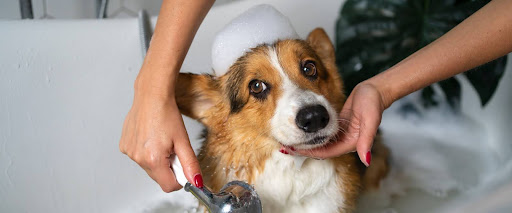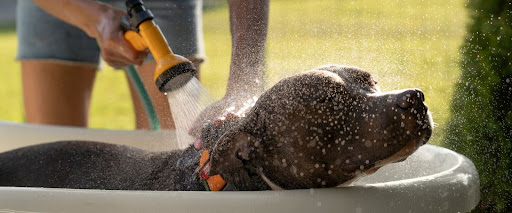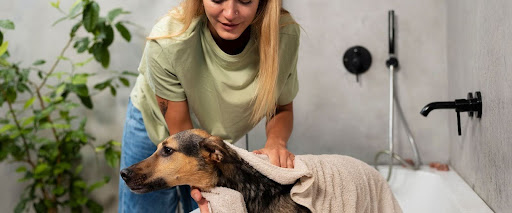If you’ve ever wondered whether your short-haired dog needs frequent baths, you’re not alone. It’s a common question among pet owners who want to ensure their dog stays clean without overdoing it. While short-haired dogs are often seen as low-maintenance compared to their long-haired counterparts, they still need a proper bathing schedule to maintain healthy skin and a shiny coat.
If you are still confused by overthinking about how often I should bathe my short-haired dog, you can get help from professional grooming services, such as Kontota, to maintain your dog’s bathing schedule for short hair and do proper dog grooming.
In this guide, we will break down the right dog bathing schedule for short hair and discuss the ideal bathing frequency for dogs based on different factors.
Understanding Your Dog’s Bathing Needs

Short-haired dogs are often thought to require less maintenance than long-haired breeds, but that’s not always the case. Even though they don’t suffer from matting or tangling, short-haired dogs still need regular grooming and bathing to maintain a healthy coat and skin. The frequency of baths largely depends on your dog’s activity level, skin health, and how much they get dirty.
How Often Should I Bathe My Short-Haired Dog?

The general rule of thumb is that short-haired dogs should be bathed every 4 to 6 weeks. However, this can vary depending on your dog’s specific circumstances. Let’s break it down further:
- Active Dogs or Outdoor Adventurers: If your dog loves playing outside, rolling around in the dirt, or swimming in the lake, you may need to bathe them more often, possibly every 3-4 weeks. Their coat will accumulate dirt, sweat, and oils faster, requiring more frequent cleaning to keep their skin from becoming irritated.
- Dogs with Sensitive Skin or Allergies: Dogs with skin issues, such as allergies or sensitive skin, may require special bathing schedules and products. If your short-haired dog has skin conditions such as eczema or dermatitis, frequent baths with the appropriate medicated shampoo may be necessary, but always consult a veterinarian before setting a schedule.
- Dogs that Stay Indoors: If your dog spends most of its time indoors and has minimal exposure to dirt or outdoor elements, you can follow the standard recommendation of bathing them every 4-6 weeks. In these cases, over-bathing can strip your dog’s skin of essential oils, leading to dryness or irritation.
- Dogs with Odor: If your short-haired dog starts to develop an odor between baths, it’s a sign that they may need more frequent cleaning. This could be due to excess oil, a skin condition, or an ear infection. Identifying the root cause of the odor can help determine the right bathing schedule for your pet.
Why Bathing Frequency for Dogs Matters
Regular bathing isn’t just about keeping your dog looking nice; it’s about maintaining their health. Bathing your dog too often or too infrequently can cause issues for your dog’s coat and skin.
- Over-Bathing: Bathing your dog too frequently can remove the natural oils from their skin, causing dryness, flakiness, and irritation. Short-haired dogs generally don’t need as many baths as long-haired dogs, and excessive cleaning can leave their skin vulnerable to environmental allergens, bacteria, and infections.
- Under-Bathing: On the other hand, not bathing your dog often enough can lead to an accumulation of oils, dirt, and bacteria, which can cause odors, itchy skin, and even infections. Keeping your dog’s coat clean prevents skin conditions and ensures they are comfortable.
How to Wash a Short-Haired Dog

Bathing a short-haired dog is relatively easy compared to long-haired breeds, but it still requires care to avoid irritating their skin. Follow these steps for a successful bath:
1. Preparation:
Make sure you have all the necessary grooming tools on hand. You’ll need:
- Dog-safe shampoo (preferably one designed for short-haired breeds)
- A gentle conditioner (optional but helpful for moisturizing)
- A towel for drying
- A brush for pre-bath grooming (especially to remove any loose hairs)
2. Brushing Before the Bath
Even short-haired dogs benefit from a good brushing before a bath. Brushing removes loose hairs and dirt, and it also helps to prevent hair from clogging your drain.
3. Bathing
Fill the tub with lukewarm water, and gently wet your dog with a shower head or a cup. Apply a small amount of shampoo, working it into a lather, and be sure to avoid getting soap in your dog’s eyes. Short-haired dogs often don’t need a lot of product, so start with a small amount and add more if necessary.
4. Rinsing Thoroughly
After scrubbing your dog, rinse thoroughly to remove all soap and shampoo. Short hair dries quickly, so be sure to rinse until the water runs clear to avoid any skin irritation.
5. Drying
Pat your dog dry with a towel, ensuring you soak up as much water as possible. If your dog enjoys it, you can use a blow dryer on the lowest setting to help dry their coat. However, be sure to keep the dryer at a safe distance from their skin to avoid burns.
6. Post-Bath Grooming
Once your dog is dry, you can give them a quick brush to remove any remaining loose hairs and help distribute the natural oils throughout their coat.
Dog Bathing Schedule for Short-Hair Dogs: Factors to Consider

While the general guideline of every 4-6 weeks is a good starting point, several factors can influence how often you bathe your short-haired dog.
- Breed-Specific Needs: Certain breeds have different skin and coat types, even within the “short-haired” category. For example, a Chihuahua’s coat may require less frequent washing compared to a Labrador’s coat, which may be oilier.
- Health Conditions: If your dog has any skin conditions, it could require more frequent bathing with medicated shampoos. Always consult your vet if you have concerns about your dog’s skin health.
- Seasonal Changes: In the warmer months, your dog may get dirtier from outdoor activities. Bathing them more frequently during the summer months is a normal practice. However, during the winter, when your dog stays indoors more often, a longer interval between baths may be sufficient.
Choose Kontota Mobile Grooming For Dog Bathing Schedule Short Hair
If you’re unsure about how to bathe your short-haired dog or need expert help, we recommend professional dog grooming services. Kontota offers specialized grooming tailored to your pet’s needs, including bathing, haircut, trimming, and more. Their experienced groomers can create a personalized grooming schedule based on your dog’s breed, activity level, and skin health.
Conclusion – How To Wash A Short-Haired Dog
Hopefully, you can get the answer to your question: How often should I bathe my short-haired dog? Now you are aware of various factors such as their activity level, health, and environment. Generally, bathing your dog every 4 to 6 weeks will help keep it clean and healthy. But remember, it’s important not to over-bathe your dog, as this can lead to dry skin. Always monitor your dog’s coat and skin health to adjust their bathing schedule as needed.
For professional grooming services, you should opt for Kontota, where you can trust their experts to care for your dog with the right grooming schedule and techniques. So, why wait? Contact the best dog groomers and give your dog a token of love by scheduling a grooming session.
FAQs: How Often Should I Bathe My Short-Haired Dog?
Can I bathe my short-haired dog every week?
Bathing your short-haired dog every week can dry out their skin and coat, leading to irritation. Stick to every 4-6 weeks unless your dog gets particularly dirty.
What is the best shampoo for short-haired dogs?
Choose a dog-safe shampoo formulated for your dog’s skin type. For sensitive skin, go for a hypoallergenic formula. Always avoid human shampoos, as they can be too harsh for pets.
Should I use a conditioner for my short-haired dog?
Conditioning is optional, but it can help moisturize your dog’s skin, especially if they have dry patches. Use a dog-friendly conditioner designed for their coat type.
Can I bathe my dog without shampoo?
While it’s not ideal, in a pinch, you can bathe your dog with water alone. However, using shampoo designed for dogs helps remove dirt, oils, and bacteria more effectively.



